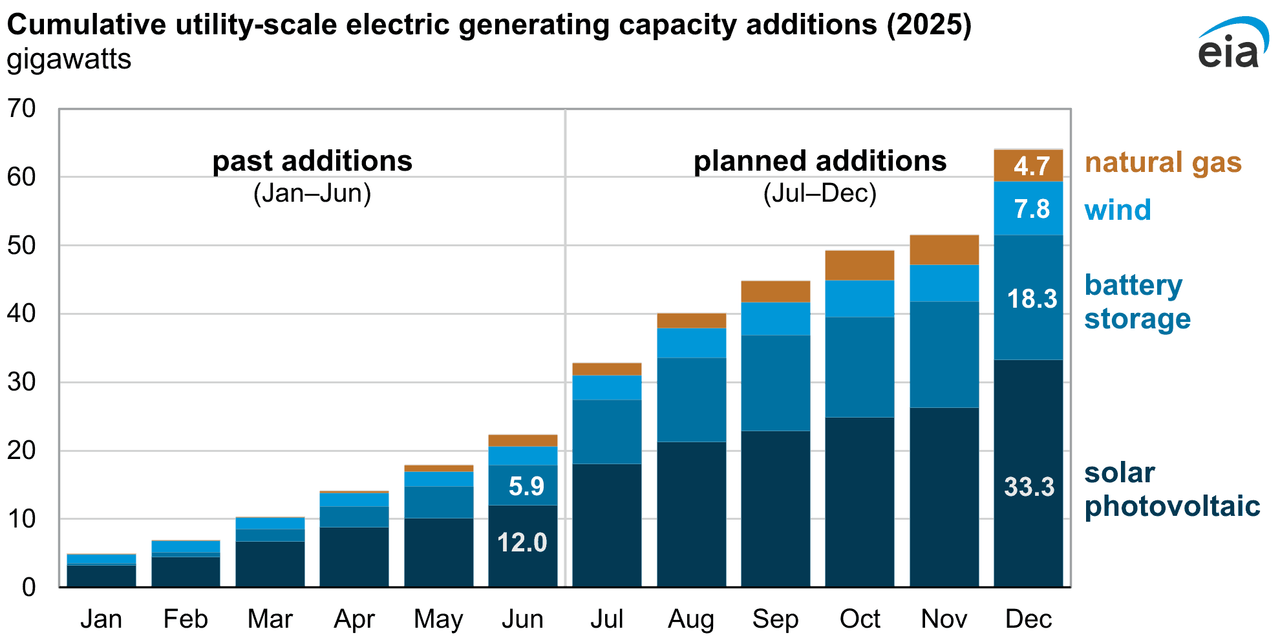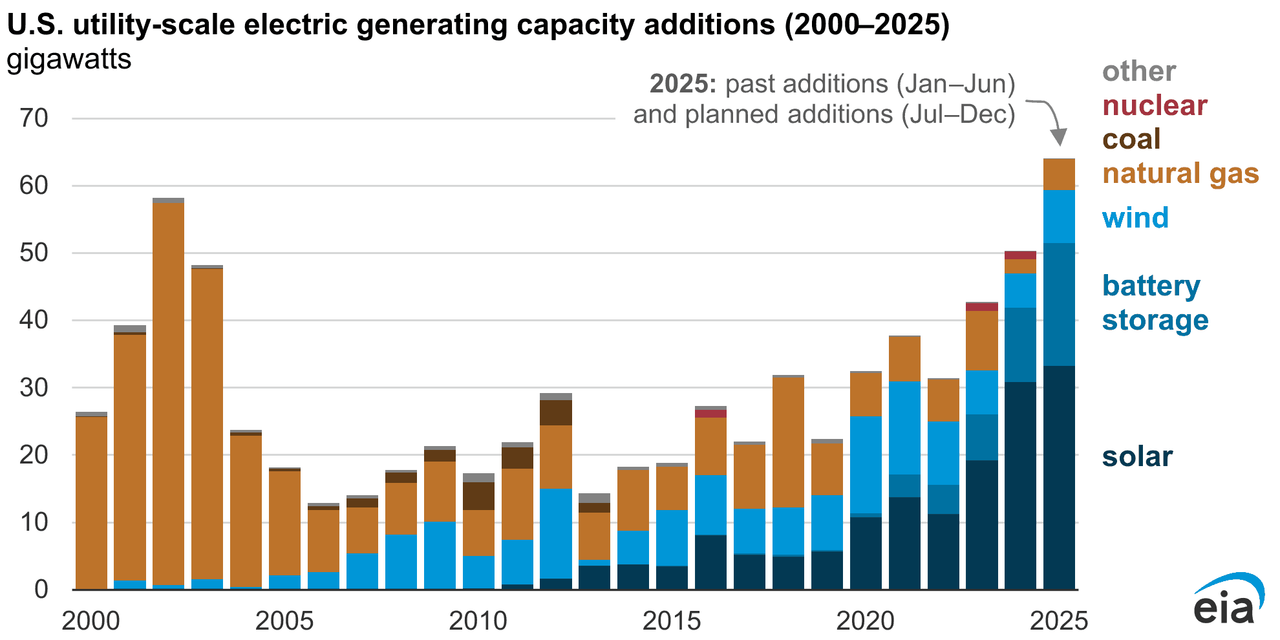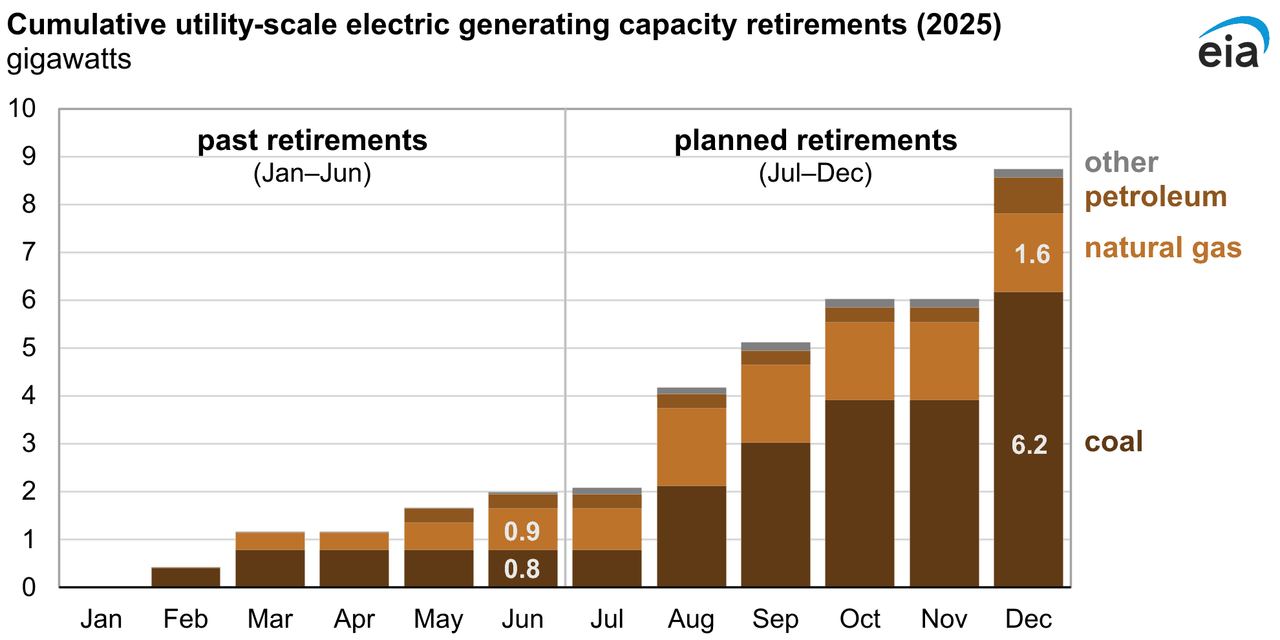Welcome to DU!
The truly grassroots left-of-center political community where regular people, not algorithms, drive the discussions and set the standards.
Join the community:
Create a free account
Support DU (and get rid of ads!):
Become a Star Member
Latest Breaking News
Editorials & Other Articles
General Discussion
The DU Lounge
All Forums
Issue Forums
Culture Forums
Alliance Forums
Region Forums
Support Forums
Help & Search
Environment & Energy
Related: About this forumU.S. developers report half of new electric generating capacity will come from solar
https://www.eia.gov/todayinenergy/detail.php?id=65964In-brief analysis
August 20, 2025
U.S. developers report half of new electric generating capacity will come from solar

Data source: U.S. Energy Information Administration, Preliminary Monthly Electric Generator Inventory, June 2025
Developers added 12 gigawatts (GW) of new utility-scale solar electric generating capacity in the United States during the first half of 2025, and they plan to add another 21 GW in the second half of the year, according to our latest survey of electric generating capacity changes. If those plans are realized, solar would account for more than half of the 64 GW that developers plan to bring online this year. Battery storage, wind, and natural gas power plants account for virtually all of the remaining capacity additions for 2025.
Developers could set a record for capacity additions if all 64 GW come online this year. The previous record for U.S. generating capacity additions was set in 2002, when developers added 58 GW to the grid, 57 GW of which was fueled by natural gas. Although developers have added natural gas-fired capacity each year since then, other technologies such as wind, solar, and battery storage have become more prevalent options for new capacity.

Data source: U.S. Energy Information Administration, Preliminary Monthly Electric Generator Inventory, June 2025
If planned capacity additions for solar photovoltaic and battery storage capacities are realized, both technologies will add more capacity than in any previous year. For both technologies, this growth is largely attributable to changes occurring in Texas.
About 27% (3.2 GW) of the solar capacity added so far in 2025 is in Texas, and developers plan to bring another 9.7 GW of solar online in Texas in the second half of this year. Last year, Texas surpassed California as the state with the most utility-scale solar capacity.
Battery storage accounted for the second-largest share of capacity additions in the first half of the year, at 26% (5.9 GW), about half of which was in Arizona or California. Developers in Texas are expecting to bring 7.0 GW of battery storage capacity online in 2025, with much of that capacity coming online in the second half of the year.
Developers retired relatively little generating capacity in the first half of 2025. Of the 8.7 GW of electric generating capacity that U.S. operators plan to retire during 2025, only 2.0 GW was retired in the first half of the year. Compared with the planned 2025 capacity retirements reported at the beginning of the year, more than 3.6 GW has now been delayed or canceled, including plans to retire the coal-fired Units 1 and 2 of Brandon Shores (1.3 GW) and oil-fired Units 3 and 4 of Herbert A Wagner (0.7 GW) in Maryland as well as the natural gas-fired Units 1, 2, and 3 of the V H Braunig plant (0.9 GW) in Texas. If current retirement intentions are realized, coal-fired power plants will account for 71% of the retired capacity this year, followed by natural gas (19%).

Data source: U.S. Energy Information Administration, Preliminary Monthly Electric Generator Inventory, June 2025
…
August 20, 2025
U.S. developers report half of new electric generating capacity will come from solar

Data source: U.S. Energy Information Administration, Preliminary Monthly Electric Generator Inventory, June 2025
Developers added 12 gigawatts (GW) of new utility-scale solar electric generating capacity in the United States during the first half of 2025, and they plan to add another 21 GW in the second half of the year, according to our latest survey of electric generating capacity changes. If those plans are realized, solar would account for more than half of the 64 GW that developers plan to bring online this year. Battery storage, wind, and natural gas power plants account for virtually all of the remaining capacity additions for 2025.
Developers could set a record for capacity additions if all 64 GW come online this year. The previous record for U.S. generating capacity additions was set in 2002, when developers added 58 GW to the grid, 57 GW of which was fueled by natural gas. Although developers have added natural gas-fired capacity each year since then, other technologies such as wind, solar, and battery storage have become more prevalent options for new capacity.

Data source: U.S. Energy Information Administration, Preliminary Monthly Electric Generator Inventory, June 2025
If planned capacity additions for solar photovoltaic and battery storage capacities are realized, both technologies will add more capacity than in any previous year. For both technologies, this growth is largely attributable to changes occurring in Texas.
About 27% (3.2 GW) of the solar capacity added so far in 2025 is in Texas, and developers plan to bring another 9.7 GW of solar online in Texas in the second half of this year. Last year, Texas surpassed California as the state with the most utility-scale solar capacity.
Battery storage accounted for the second-largest share of capacity additions in the first half of the year, at 26% (5.9 GW), about half of which was in Arizona or California. Developers in Texas are expecting to bring 7.0 GW of battery storage capacity online in 2025, with much of that capacity coming online in the second half of the year.
Developers retired relatively little generating capacity in the first half of 2025. Of the 8.7 GW of electric generating capacity that U.S. operators plan to retire during 2025, only 2.0 GW was retired in the first half of the year. Compared with the planned 2025 capacity retirements reported at the beginning of the year, more than 3.6 GW has now been delayed or canceled, including plans to retire the coal-fired Units 1 and 2 of Brandon Shores (1.3 GW) and oil-fired Units 3 and 4 of Herbert A Wagner (0.7 GW) in Maryland as well as the natural gas-fired Units 1, 2, and 3 of the V H Braunig plant (0.9 GW) in Texas. If current retirement intentions are realized, coal-fired power plants will account for 71% of the retired capacity this year, followed by natural gas (19%).

Data source: U.S. Energy Information Administration, Preliminary Monthly Electric Generator Inventory, June 2025
…
2 replies
 = new reply since forum marked as read
Highlight:
NoneDon't highlight anything
5 newestHighlight 5 most recent replies
= new reply since forum marked as read
Highlight:
NoneDon't highlight anything
5 newestHighlight 5 most recent replies
U.S. developers report half of new electric generating capacity will come from solar (Original Post)
OKIsItJustMe
Aug 2025
OP
America's clean-energy industry is growing despite Trump's attacks. At least for now
OKIsItJustMe
Aug 2025
#2
NNadir
(36,989 posts)1. What a disaster! Solar "capacity" has an extraordinary low capacity utilization.
Thus what it means is more redundant fossil fuel systems sitting idle for short periods and required to ramp up with wasted energy, and unable to recover O&M costs associated with the down time for an affectation.
The popularity of this garbage is driving high electricity prices and represents a subsidy paid by the poor to the rich and stupid.
OKIsItJustMe
(21,672 posts)2. America's clean-energy industry is growing despite Trump's attacks. At least for now
https://www.npr.org/2025/03/12/nx-s1-5319056/trump-clean-energy-electricity-climate-change
Will fossil fuels "fill in" during long “energy droughts?” That’s likely; for a time, carbon emissions and electricity prices will rise.
https://www.pnnl.gov/news-media/even-months-long-energy-droughts-power-grid-remains-resilient
So, what would happen if those solar farms with BESS were not rolled out? How would the increasing demand be met? Most likely by building more fossil fuel plants (not nuclear plants.)
https://www.datacenterdynamics.com/en/news/entergy-obtains-approval-to-construct-three-gas-facilities-to-serve-metas-2gw-data-center-in-louisiana/
Would you prefer to see demand met by increasing renewable sources, with occasional support from fossil fuels or 💯% fossil fuels.
America's clean-energy industry is growing despite Trump's attacks. At least for now
March 12, 20255:33 AM ET
Heard on Morning Edition
By Michael Copley
Despite the Trump administration's wide-ranging attacks on renewables like wind and solar power, the clean-energy industry is on pace for record growth this year, according to government analysts.
The buildout of big solar and battery plants is expected to hit an all-time high in 2025, accounting for 81% of new power generation that companies will add to America's electric grids, the Energy Information Administration (EIA) said in a recent report. Including wind projects, the share of new power capacity that's expected to come online this year from renewables and batteries jumps to 93%, the EIA said.
The U.S. needs all the power it can get, because electricity demand is surging for the first time in decades, industry analysts and executives say. That means kickstarting development of nuclear power and geothermal projects, burning more natural gas and, in some cases, delaying retirement of old coal plants. But in the scramble for electricity, renewable-energy and battery plants are crucial, analysts and executives say, because they're quick to build and provide electricity that's relatively cheap.
"There is no doubt that the increased demand for electricity over the next decade, coming from data centers and advanced manufacturing, will continue to require vast amounts of renewable energy and batteries," Andrés Gluski, chief executive of The AES Corporation, a power company that owns both clean-energy and fossil-fuel plants, told Wall Street analysts recently.
…
March 12, 20255:33 AM ET
Heard on Morning Edition
By Michael Copley
Despite the Trump administration's wide-ranging attacks on renewables like wind and solar power, the clean-energy industry is on pace for record growth this year, according to government analysts.
The buildout of big solar and battery plants is expected to hit an all-time high in 2025, accounting for 81% of new power generation that companies will add to America's electric grids, the Energy Information Administration (EIA) said in a recent report. Including wind projects, the share of new power capacity that's expected to come online this year from renewables and batteries jumps to 93%, the EIA said.
The U.S. needs all the power it can get, because electricity demand is surging for the first time in decades, industry analysts and executives say. That means kickstarting development of nuclear power and geothermal projects, burning more natural gas and, in some cases, delaying retirement of old coal plants. But in the scramble for electricity, renewable-energy and battery plants are crucial, analysts and executives say, because they're quick to build and provide electricity that's relatively cheap.
"There is no doubt that the increased demand for electricity over the next decade, coming from data centers and advanced manufacturing, will continue to require vast amounts of renewable energy and batteries," Andrés Gluski, chief executive of The AES Corporation, a power company that owns both clean-energy and fossil-fuel plants, told Wall Street analysts recently.
…
Will fossil fuels "fill in" during long “energy droughts?” That’s likely; for a time, carbon emissions and electricity prices will rise.
https://www.pnnl.gov/news-media/even-months-long-energy-droughts-power-grid-remains-resilient
December 11, 2024 News Release
Even with Months-Long “Energy Droughts,” the Power Grid Remains Resilient
Understanding compound energy droughts can help utilities plan ahead and invest in energy storage
JoAnna Wendel, PNNL
WASHINGTON, DC—On a power grid partly supported by wind turbines, solar panels and hydropower turbines, weather and climate patterns can significantly affect how much power is produced. And as more wind and solar are added to the grid, utilities will need to understand how seasonal patterns in climate and weather might cause swings in energy generation.
In new research, a team from the Department of Energy’s Pacific Northwest National Laboratory shows that compound energy droughts—or periods of low energy generation from solar, wind and hydropower simultaneously—can last up to five months and occur most often in the fall.
Importantly, “compound energy droughts don’t necessarily cause blackouts, and consumers may not notice one was occurring,” said Cameron Bracken, Earth scientist at PNNL and lead author on the paper. And in fact, the team found that in the western United States, the sheer amount of non-renewable generation means that even in the worst-case energy drought scenario, there’s still enough energy available to meet demand.
“The question then becomes about the cost of energy and how to effectively deploy energy storage,” Bracken said. “During a compound energy drought, utilities would have to use more energy from burning fossil fuels to meet demand or purchase energy on the market.”
And burning fossil fuels costs more and emits more carbon dioxide. Knowing when a compound energy drought might occur, and how long it might last, allows utility operators to not only plan for how to cost-effectively provide energy to consumers, but also how to invest in energy storage.
…
Even with Months-Long “Energy Droughts,” the Power Grid Remains Resilient
Understanding compound energy droughts can help utilities plan ahead and invest in energy storage
JoAnna Wendel, PNNL
WASHINGTON, DC—On a power grid partly supported by wind turbines, solar panels and hydropower turbines, weather and climate patterns can significantly affect how much power is produced. And as more wind and solar are added to the grid, utilities will need to understand how seasonal patterns in climate and weather might cause swings in energy generation.
In new research, a team from the Department of Energy’s Pacific Northwest National Laboratory shows that compound energy droughts—or periods of low energy generation from solar, wind and hydropower simultaneously—can last up to five months and occur most often in the fall.
Importantly, “compound energy droughts don’t necessarily cause blackouts, and consumers may not notice one was occurring,” said Cameron Bracken, Earth scientist at PNNL and lead author on the paper. And in fact, the team found that in the western United States, the sheer amount of non-renewable generation means that even in the worst-case energy drought scenario, there’s still enough energy available to meet demand.
“The question then becomes about the cost of energy and how to effectively deploy energy storage,” Bracken said. “During a compound energy drought, utilities would have to use more energy from burning fossil fuels to meet demand or purchase energy on the market.”
And burning fossil fuels costs more and emits more carbon dioxide. Knowing when a compound energy drought might occur, and how long it might last, allows utility operators to not only plan for how to cost-effectively provide energy to consumers, but also how to invest in energy storage.
…
So, what would happen if those solar farms with BESS were not rolled out? How would the increasing demand be met? Most likely by building more fossil fuel plants (not nuclear plants.)
https://www.datacenterdynamics.com/en/news/entergy-obtains-approval-to-construct-three-gas-facilities-to-serve-metas-2gw-data-center-in-louisiana/
Entergy obtains approval to construct three gas facilities to serve Meta's 2GW data center in Louisiana
Two units expected to come online in 2028, with the final unit slated for operations in 2029 for Hyperion
August 21, 2025 By Zachary Skidmore
The Louisiana Public Service Commission (LPSC) has given the go-ahead for the installation of three natural gas turbines set to power Meta’s planned 2GW data center in Richland Parish, Louisiana.
US utility Entergy received approval from the Commission yesterday (20 August) to construct the three combined-cycle combustion turbine generation facilities. The three turbines are expected to have a combined capacity of 2.26GW.
Two of the units are expected to come online in 2028, with the third facility, built at Entergy Louisiana's existing Waterford site in St. Charles Parish, expected to commence operations in late 2029.
"Today's decision by the Commission is a critical step toward ensuring the long-term reliability and affordability of electric service for all of our customers," said Phillip May, Entergy Louisiana president and CEO.
…
Two units expected to come online in 2028, with the final unit slated for operations in 2029 for Hyperion
August 21, 2025 By Zachary Skidmore
The Louisiana Public Service Commission (LPSC) has given the go-ahead for the installation of three natural gas turbines set to power Meta’s planned 2GW data center in Richland Parish, Louisiana.
US utility Entergy received approval from the Commission yesterday (20 August) to construct the three combined-cycle combustion turbine generation facilities. The three turbines are expected to have a combined capacity of 2.26GW.
Two of the units are expected to come online in 2028, with the third facility, built at Entergy Louisiana's existing Waterford site in St. Charles Parish, expected to commence operations in late 2029.
"Today's decision by the Commission is a critical step toward ensuring the long-term reliability and affordability of electric service for all of our customers," said Phillip May, Entergy Louisiana president and CEO.
…
Would you prefer to see demand met by increasing renewable sources, with occasional support from fossil fuels or 💯% fossil fuels.